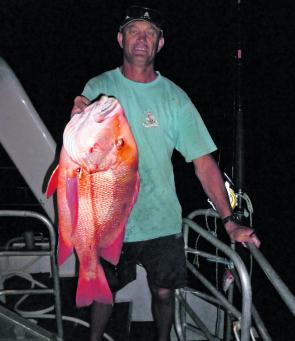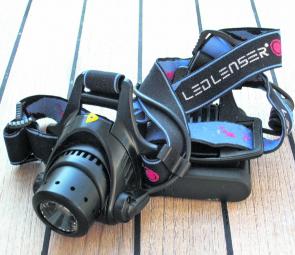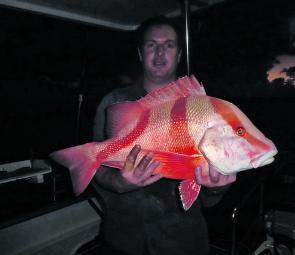So your mates have invited you out on a reef fishing overnighter; but you’ve never been offshore shore before. No problems, here’s a down and dirty on the basics so that you can at least understand what they are talking about.
First time anglers might get confused with all the equipment and the many options that seasoned crews will talk about using on a fishing trip; in this article with the south-east Queensland reef fishing season upon us, let’s look at the equipment basics for anglers to consider.
There are a number of scenarios where I like to reef fish at anchor on an overnighter.
Out in Moreton Bay or Hervey Bay there are plenty of islands to fish around, most of these would fall into the category of a shallow water fishery (if not very shallow). As well there are the main islands of Moreton Island and Fraser Island respectively. Along the inside of these islands there are quite a few likely spots for reef fishing that also make great overnight anchorages, the inside ledge of Moreton Island from Cowan Point up to Comboyuro Point including the area out the front of Bulwer is an example of such. Other spots are the close in offshore reefs; Shallow Tempest on the eastern side of Moreton Island is one that springs to mind. These spots can either be the focus of a specific trip, or they are great as an overnighter on a Saturday night when you are out for the entire weekend.
For more serious trips where the excursion is specifically a night fishing trip, in good weather crews may head out to the deeper water reefs in the afternoon and fish all night to return after the dawn session the next morning.
If you ever get the chance, being anchored up for the night inside the Great Barrier Reef is one of life’s bucket list reef fishing experiences.
Be it on a primarily marlin fishing trip out of Cairns, or a week long charter boat reef fishing trip out around the Swains, the fishing is often amazing and not to be missed when you anchor up behind the reef overnight.
The best fishing times during an overnighter are close to the turn of the tide when the run (current) slows enough to let you get your baits down with the least weight (sinkers) as possible. The other best times are dusk and dawn. However it can be important to differentiate your fishing strategies from the dark to the light. For example, out on a northern Queensland reef, just before dawn, I may drop a live bait down in the hope of a red emperor while it is still dark. Soon after though, in the grey light I’ll slip the surface floater out with a live bait. The plan is to tempt a big Spanish mackerel. Once the mackerel line is set I’ll switch to a bottom basher with flesh baits to seduce a coral trout.
Switched on anglers will be up an hour or so before dawn to ensure that their gear is ready and 100% rigged before the fishing opportunities present. It’s the guy who is stumbling around and still tying his knots who misses the often narrow bite window. It is handy to know these times when the action is likely to start, that way you to get ensure that both yourself and your equipment are ready to go.
Many crews put one line out (sometimes a second) as a floater specifically to target mackerel. This outfit is rigged on wire and is most productive around the grey light of dusk and dawn. It is common to put the live bait out under a balloon at dusk but to then bring it in once it gets dark as such baits tend to end up getting sharked once the sun has completely gone. Incidentally, at night most anglers try to get their live baits down deep closer to the bottom in order to hopefully avoid prowling sharks; I’ve caught quite a few mackerel by employing this strategy (and quite a few sharks too).
If you are into tuna (think sashimi) then put out a surface live bait on a mono nylon type trace. Tuna are more likely to bite throughout the day (although dusk and dawn are often still the best times). Accordingly one strategy can be to fish your live bait(s) on mono traces during the day and then switch to wire trace for your live baiting for mackerel at dusk and dawn.
Of course there is another type of ‘floater’ technique which is the slow sinking outfit, using ball sinkers, which we use to target snapper that are suspended around the edges of the reefs. How this very successful technique (and one or two others by the way) gets called floaters is something that I have never worked out. I’m just mentioning it here so that you are forewarned about the potentially confusing crossover of terms.
Typically the surface live bait outfit uses a metre or so of wire at the hook end, and not only is the bait deployed unweighted, it is also often set out under a balloon. It is quite a thrill to watch a balloon zipping across the surface before you set the hooks on the mackerel that is towing it along.
Because the surface live bait outfit is set up to let the target fish run with the bait before the hook-up, it is most common to use a lever drag overhead reel on your mackerel outfit.
If you are intending to fish a floater then deploy it first. Once it is set in position and set in a rod holder you can then switch over to using your bottom basher rig.
There are two types of bait that you will put out for mackerel on unweighted lines. Generally either a pilchard dead bait on a rig of 3x ganged 5/0 hooks; or a live bait on a 7/0 to 8/0 hook. The live bait ideally will have a stinger hook in the tail that is rigged on a short piece of wire that connects the stinger hook to the front hook. Oh and of course, BYO party balloons and rubber bands to connect them to the line.
The basics knots that you should practice before you go out mackerel fishing include the following (of course you can also make up a few wire rigs, and a mono trace or two, before you go and store them individually in clip seal bags):
locked half-blood (for your mono type fishing lines),
haywire twist and barrel roll for your single strand mackerel wire.
If you are going to use multistrand wire instead of single strand for your wire traces, then you’ll need crimps to match the wire as well as a crimping tool. It is a good idea to use the Flemish Eye when crimping, so practice this connection loop as well.
Some multistrand wire is tieable (aka knotable) and one beauty of it is that they show you the knots to use on the side of the wire’s spool.
The bottom basher rig, often rigged with a paternoster rig at the fish tempting end, with two hooks rigged on droppers and a snapper lead on the bottom, needs to be hand held in order to control the rate of descent of the baits to the sea floor and to feel the bites once you get there. An overhead reel with a good free spool is the most commonly used option.
If you choose an M10 style rod for this outfit it can double as an outfit on which to run a slow sinking ball sinker rig (although most ball sinker rods for suspended snapper are about half a metre longer than a M10 bottom basher).
Keep it simple is the catch phrase for hooks, a selection of hooks from sizes 5/0 to 7/0 in both ‘J’ hook and circle hook patterns will cover the options. Take about a dozen of each if you are going on an overnighter, take 50 to 100 of each if you are going out for a week.
You should also carry a selection of trace material, small spools of 50m up to 100m each, of breaking strains between approx. 20, 30 and 40 kg are the go.
As far as sinkers go, my advice is that you pitch in some dollars and let your more experienced mates provide your sinkers. Otherwise a trailer boat can get seriously weighed down if three blokes rock up each with their own supply of sinkers to cover every ‘what if’ situation. On the trailer boats that I fish on, we consider that sinkers are supplied by the boat owner and that they are a boat expense just like fuel for everybody to pitch in for and share the costs. To reduce the costs, often our sinkers are manufactured before the start of a season at a backyard BBQ event that we call a sinker pour; everybody contributes a bucket of lead and some man hours, and the boat then has enough sinkers for the upcoming season.
The basics knots that you should practice for reef fishing before you go out include the following:
locked half-blood,
dropper loop, and
overhand loop.
I recommend that you take two multipurpose outfits that can cover both surface livebaiting and bottom bashing. Rods like the classic ‘M10’ (check out the versions made by Wilsons) with overhead reels to match are ideal. Boats are getting bigger with every generation and you might be fortunate enough to get on a boat that allows you to take three or more outfits, however that’s a lot of outlay and too many purchase decisions for a novice to be thinking about – best get the basics sorted first.
One item that I recommend that everybody packs for a night trip is one of those low cost headlamps (and wears it). Having a light that you can turn on in an instant all the while having both hands free to tie a knot or fix a tangle makes them better than sliced bread.
A non-rusting multitool with pliers and also a short bait knife will get you through 90% of situations independently without you having to pester your fellow crew members too much.
Of course all of the above techniques can be refined in much greater detail; each of them can be expanded into an article or two in themselves. However when first starting out the best place to start is with a good general knowledge, ‘speak the lingo’ so to speak. Then hopefully you’ll know what your experienced mates and crew are on about so that you can participate and learn more as you go along.
Here’s a tip; many of my past articles, and also the articles of all the other QFM writers, that expand on these above mentioned techniques are available on the Fishing Monthly website www.fishingmonthly.com.au. Surf there and check them out.
Reads: 7071
Spaniards are best targeted in the grey light of dusk and dawn

The Red Emperor is the holy grail capture for night time reef fishing trips from waters of Hervey Bay and further north. Red Emperor are best targeted on live baits down deep at night time when at anchor.

A headlamp is one of the handiest pieces of night-time fishing kit that the world has come up with.

Red emperor come in all shapes and sizes and are a pleasure to catch at any time on anovernighter.




